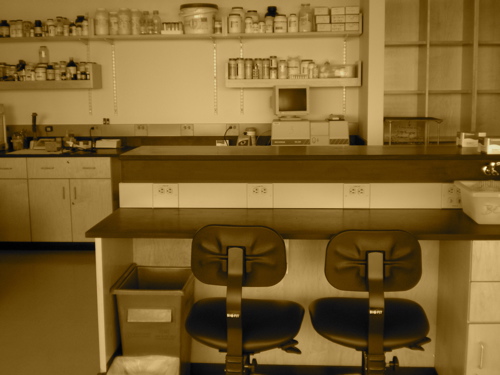Difference between revisions of "20.109(S10):Purify RNA and run affinity column (Day4)"
From Course Wiki
(→Protocols) |
(→Part 5: Begin RNA precipitation) |
||
| Line 31: | Line 31: | ||
===Part 5: Begin RNA precipitation=== | ===Part 5: Begin RNA precipitation=== | ||
| + | |||
| + | #Measure the approximate volume (to within a few μL) of solution recovered. | ||
| + | #Add 1/10 volume of ammonium acetate, 1/200 glycogen, and 2.5 100% ethanol, in that order. | ||
| + | #*For example, for a 200 μL solution, you would add 20 μL of the ammonium acetate. | ||
| + | # Give the teaching faculty your samples to be put away at -20 °C until next time. | ||
==For next time== | ==For next time== | ||
==Reagent list== | ==Reagent list== | ||
Revision as of 18:15, 6 January 2010
Contents
Introduction
Protocols
Part 1: Prepare spin purification columns and purify RNA
- Take your thawed IVTs from last time, and add 1/10 volume of DNase to each reaction. Place on the 37 °C heat block for 30 min, and meanwhile prepare the columns.
- During spins and incubations, you may also be able to begin Part 2 below.
- Take one Micro Bio-Spin Columns and one 2 mL microfuge tube per reaction, and for each:
- Rapidly flip the column back and forth to resuspend the gel, then flick or tap it to rid air bubbles.
- Snap off the plastic tab at the bottom of the column (a little buffer may flow out), and place the column in the 2 mL microfuge tube. Let the excess buffer drain off.
- When the buffer stop flowing, centrifuge the tube for 2 min at 1000 g. (Is g the same as rcf or rpm? Ask if you’re not sure!)
- Add 500 μL of Selection Buffer to the top of the column. Let it drain by gravity for a couple of minutes, then spin for 1 min at 1000g.
- Repeat step 6 three more times. Meanwhile, label 1.5 mL eppendorf tubes for collection (on the side and with a label on the cap), and cut off their caps.
- Transfer each column to a 1.5 mL tube – both column and tube should be labeled, to be on the safe side – then add 75 μL of your IVT reaction gently to the center of the top surface of the gel.
- Centrifuge for 4 min, at 1000 g. Carefully replace the cap on each sample, and store on ice for now.
Part 2: Quantify RNA recovery
- For each RNA sample, you will add 5 μL of RNA to 695 μL of water. This ought to give you a measurement that's in a good readability range. You can prepare labeled eppendorf tubes containing the appropriate amount of water in advance.
- To get the most accurate measurement, you should also prepare a blanking solution that contains everything except the RNA. Per sample, that means 695 μL of water and 5 μL of selection buffer.
- As your RNA samples are ready, first measure the volume recovered to within a couple of mu;L (usually it is 85-90). Only then take 5 μL and to a water-filled eppendorf.
- Add 695 μL of blanking solution to a cuvette, and hit Blank on the spectrophotometer. Then dump the blanking solution, and add 695 μL of your RNA solution instead. Record the 260 nm and 280 nm absorbance values in your notebook. You can simply touch your finger on the screen for coarse wavelength selection, then touch the arrows for fine selection.
- Repeat for each sample.
Part 3: Prepare RNA for selection
Part 4: Column selection
Part 5: Begin RNA precipitation
- Measure the approximate volume (to within a few μL) of solution recovered.
- Add 1/10 volume of ammonium acetate, 1/200 glycogen, and 2.5 100% ethanol, in that order.
- For example, for a 200 μL solution, you would add 20 μL of the ammonium acetate.
- Give the teaching faculty your samples to be put away at -20 °C until next time.
